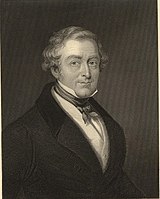First Peel ministry | |
|---|---|
 | |
| 1834–1835 | |
 Sir Robert Peel | |
| Date formed | 10 December 1834 |
| Date dissolved | 8 April 1835 |
| People and organisations | |
| Monarch | William IV |
| Prime Minister | Sir Robert Peel |
| Status in legislature | Minority |
| Opposition leaders | |
| History | |
| Outgoing election | 1835 general election |
| Predecessor | Wellington caretaker ministry |
| Successor | Second Melbourne ministry |
Sir Robert Peel's first government succeeded the caretaker ministry of Arthur Wellesley, 1st Duke of Wellington. Peel was also Chancellor of the Exchequer while the Duke of Wellington served as Foreign Secretary. A young William Ewart Gladstone held office as a Junior Lord of the Treasury, his first governmental post in a ministerial career that would span for the next sixty years.
Contents
The Peel ministry was a minority government, and relied on Whig support. However, this the Whigs felt disinclined to give, joining with the Irish radicals to defeat the Conservatives at every turn. After a reign of only four months, the government felt obliged to resign, whereupon the Whig leader William Lamb, 2nd Viscount Melbourne formed his second government.
